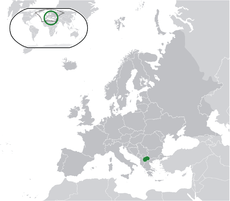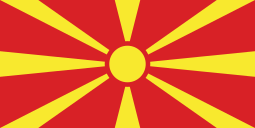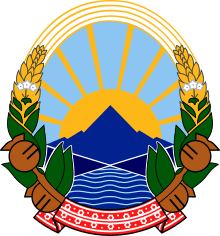Outline of North Macedonia
The following outline is provided as an overview of and topical guide to North Macedonia:


North Macedonia is a landlocked sovereign country located on the Balkan Peninsula in Southern Europe.[1] North Macedonia is bordered by Serbia and Kosovo[a] to the north, Albania to the west, Greece to the south, and Bulgaria to the east.
It was admitted to the United Nations in 1993 under the provisional reference the former Yugoslav Republic of Macedonia[2][3] commonly abbreviated to FYROM,[4][5] pending resolution of a naming dispute with Greece.[6] Many other international institutions and countries recognised the country under the same reference, although an overall majority of countries recognised it under its constitutional name.[7]
North Macedonia forms approximately 35.8% of the land and 40.9% of the population of the wider geographical region of Macedonia, as it was defined in the late 19th century. The capital is Skopje, with 506,926 inhabitants according to a 2002 census, and there are a number of smaller cities, notably Bitola, Kumanovo, Prilep, Tetovo, Ohrid, Veles, Štip, Kočani, Gostivar and Strumica. It has more than 50 natural and artificial lakes and sixteen mountains higher than 2,000 meters (6,550 ft).
The country is a member of the UN, NATO, and the Council of Europe and is also a member of La Francophonie, the World Trade Organization (WTO), and the Organization for Security and Cooperation in Europe. Since December 2005 it is also a candidate for joining the European Union.
General reference

- Pronunciation:
- Common English country name: North Macedonia
- Official English country name: The Republic of North Macedonia
- Common endonym(s): Severna Makedonija – Северна Македонија
- Official endonym(s): Republika Severna Makedonija – Република Северна Македонија
- Adjectival(s): Macedonian
- Demonym(s): Macedonians
- Etymology: Greek: Μακεδονία, Makedonía, related to the ancient Greek word μακεδνός (Makednos)
- ISO country codes: MK, MKD, 807
- ISO region codes: See ISO 3166-2:MK
- Internet country code top-level domain: .mk
Geography of North Macedonia
- North Macedonia is: a country
- Location:
- Eastern Hemisphere
- Northern Hemisphere
- Eurasia
- Europe
- Southern Europe
- Balkans (also known as "Southeastern Europe")
- Southern Europe
- Europe
- Eurasia
- Time zone: Central European Time (UTC+01), Central European Summer Time (UTC+02)
- Extreme points of North Macedonia
- High: Mount Korab (Golem Korab) 2,764 m (9,068 ft)
- Low: Vardar 50 m (164 ft)
- Land boundaries: 839 km
- Population of North Macedonia:
- Area of North Macedonia:
- Atlas of North Macedonia
Environment of North Macedonia

- Climate of North Macedonia
- Environmental issues in North Macedonia
- Renewable energy in North Macedonia
- Geology of North Macedonia
- Protected areas of North Macedonia
- Biosphere reserves in North Macedonia
- National parks of North Macedonia
- Wildlife of North Macedonia
Natural geographic features of North Macedonia
- Mountains of North Macedonia
- List of World Heritage sites in North Macedonia
Regions of North Macedonia
Ecoregions of North Macedonia
Administrative divisions of North Macedonia
Municipalities of North Macedonia
- Capital of North Macedonia: Skopje
- List of cities in North Macedonia
Statistical Regions of North Macedonia
Demography of North Macedonia
Government and politics of North Macedonia
- Form of government:
- Capital of North Macedonia: Skopje
- Elections in North Macedonia
- List of political parties in North Macedonia
Branches of the government of North Macedonia
Executive branch of the government of North Macedonia
- Head of state: President of North Macedonia,
- Head of government: Prime Minister of North Macedonia,
- Cabinet of North Macedonia
Legislative branch of the government of North Macedonia
- Parliament: Assembly of North Macedonia (unicameral)
Judicial branch of the government of North Macedonia
- Supreme Court of North Macedonia
Foreign relations of North Macedonia
- Diplomatic missions in North Macedonia
- Diplomatic missions of North Macedonia
- Greece–North Macedonia relations
International organization membership
North Macedonia is a member of:[1]
Law and order in North Macedonia
- Constitution of North Macedonia
- Crime in North Macedonia
- Human rights in North Macedonia
- Law enforcement in North Macedonia
- Nationality law of North Macedonia
- North Macedonian passport
- Macedonian identity card
Military of North Macedonia
- Command
- Forces
- Army of North Macedonia
- Macedonian Lake Patrol Police
- North Macedonia Air Force
- Special forces of North Macedonia
- Military history of North Macedonia
- Military ranks of North Macedonia
Local government in North Macedonia
History of North Macedonia
Culture of North Macedonia
- Architecture of North Macedonia
- Cuisine of North Macedonia
- List of festivals in North Macedonia
- Languages of North Macedonia
- Media of North Macedonia
- National symbols of North Macedonia
- Coat of arms: National emblem of North Macedonia
- Flag of North Macedonia
- National anthem of North Macedonia: Denes nad Makedonija
- People of North Macedonia
- Public holidays in North Macedonia
- List of records of North Macedonia
- Religion in North Macedonia
- Christianity in North Macedonia
- Orthodoxy in North Macedonia
- Macedonian Orthodox Church
- Orthodox Ohrid Archbishopric
- Protestantism in North Macedonia
- Catholicism in North Macedonia
- Orthodoxy in North Macedonia
- Hinduism in North Macedonia
- Islam in North Macedonia
- Judaism in North Macedonia
- Sikhism in North Macedonia
- Christianity in North Macedonia
- List of World Heritage sites in North Macedonia
Art in North Macedonia
- Art in North Macedonia
- Cinema of North Macedonia
- Literature of North Macedonia
- Music of North Macedonia
- Television in North Macedonia
- Theatre in North Macedonia
Sports in North Macedonia
Economy and infrastructure of North Macedonia
- Economic rank, by nominal GDP (2007): 124th (one hundred and twenty fourth)
- Agriculture in North Macedonia
- Banking in North Macedonia
- Communications in North Macedonia
- Internet in North Macedonia
- List of companies of North Macedonia
- Currency of North Macedonia: Denar
- ISO 4217: MKD
- Energy in North Macedonia
- Energy policy of North Macedonia
- Oil industry in North Macedonia
- Health in North Macedonia
- Mining in North Macedonia
- Macedonia Stock Exchange
- Tourism in North Macedonia
- Transport in North Macedonia
- List of airports in North Macedonia
- Rail transport in North Macedonia
- Roads in North Macedonia
Education in North Macedonia
See also
| Macedonian language edition of Wikipedia, the free encyclopedia |
- Index of North Macedonia-related articles
- List of North Macedonia-related topics
- List of international rankings
- Member state of the United Nations
- Outline of Europe
- Outline of geography
References
- "North Macedonia". The World Factbook. United States Central Intelligence Agency. July 2, 2009. Retrieved July 23, 2009.
- United Nations Security Council Resolutions 817 of April 7 and 845 of June 18 of 1993
- "Note on Yugoslavia". Retrieved 2008-05-10. "By resolution A/RES/47/225 of 8 April 1993, the General Assembly decided to admit as a Member of the United Nations the State being provisionally referred to for all purposes within the United Nations as "The former Yugoslav Republic of Macedonia" pending settlement of the difference that had arisen over its name."
- Bonk, M. R., Carlton R. A. (editors) (1997), International Acronyms, Initialisms & Abbreviations Dictionary, 4th Edition, Detroit, New York, Toronto, London: Gale Research, LCCCN 85-642206, ISBN 0-8103-7437-4, ISSN 0743-0523, Volume 1, pg. 516 and Bonk, M. R (Project Editor) (2003), International Acronyms, Initialisms & Abbreviations Dictionary, 32nd Edition, USA: Gale-Thompson Group, Volume 1, pg. 1789, ISBN 0-7876-4109-X (Part 2 D-I only)
- Alongside the official long-form reference, the "FYROM" acronym is frequently used by international organizations such as the UN, the EU, the OSCE, the EBU, the IMF, the World Bank, WTO and NATO (All NATO documents referring to "FYROM" have to be accompanied by a footnote text 'Turkey recognises the Republic of Macedonia with its constitutional name')
- United Nations Resolution 225 (1993)
- See lists at Macedonia naming dispute
| a. | ^ Kosovo is the subject of a territorial dispute between the Republic of Kosovo and the Republic of Serbia. The Republic of Kosovo unilaterally declared independence on 17 February 2008, but Serbia continues to claim it as part of its own sovereign territory. The two governments began to normalise relations in 2013, as part of the 2013 Brussels Agreement. Kosovo is currently recognized as an independent state by 97 out of the 193 United Nations member states. In total, 112 UN member states recognized Kosovo at some point, of which 15 later withdrew their recognition. |

